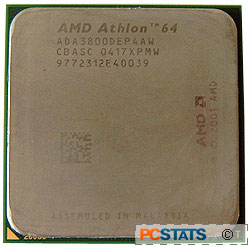Doom 3 is
the most advanced OpenGL game to date, it takes advantage of the latest
videocard technology and pushes the processing power of the CPU to its absolute
limits. At its highest setting Ultra quality, texture sizes pass the 500MB mark
which means even tomorrows videocards will have a hard time running everything.
The framerates in the game itself are locked at 60 fps so anything above that point is
wasted. Each test is run three times and with the third run being
recorded.
| Doom3 |
| LQ 640x480: |
FPS |
Ranking |
| Pentium 4 3.0C (i875P 200/400) |
76.6 |
   |
| Pentium 4 540 (915P 200/400) |
88.5 |
   |
| Pentium 4 540 (925X 200/533) |
89.7 |
   |
| AthlonXP 3200+ (NF2 Ultra 200/400) |
68.8 |
   |
| Athlon64 3200+ (NF3-250 200/400) |
92.6 |
   |
| Athlon64 3800+ (K8T800 Pro 200/400) |
104.3 |
   |
| Athlon64 3800+ (NF3 Ultra 200/400) |
102 |
   |
| Athlon64 3800+ @ 2.57 GHz |
106.5 |
   |
A strong showing by the Pentium 4 540 chip here, but the
3800+ easily takes the Doom 3 performance crown as we expected.
AMD, still on top?
One thing that plagued AMD throughout the life of the K7
was heat and noise. Sure the chips were powerful, often stealing the performance
crown from Intel, but they simply generated too much heat. To counter this,
enthusiasts and manufacturers were forced to use larger and more expensive
heatsinks, as well as more powerful (and louder) fans.
 It seems AMD has
learned from this experience and that's why all Athlon 64s have a feature called
Cool 'n' Quiet integrated into the core.
It seems AMD has
learned from this experience and that's why all Athlon 64s have a feature called
Cool 'n' Quiet integrated into the core.
To make things easier on manufacturers, AMD did not
originally require them to enable the Cool 'n' Quiet feature for motherboard
validation. This time around though, if you want to get on AMD's recommended list of motherboards, C'n'Q
as they call it must be supported and enabled by default!
Another very nifty feature that is included in all
Athlon64 Socket 939 chips is their EVP or Enhanced Virus Protection feature.
Working in conjunction with SP2 for Windows XP, it should hopefully ensure that
Athlon64 users will no longer have to worry about virus/worms that exploit
memory buffer overflow errors. That's pretty significant if it proves to work as
advertised, considering that a large number of the viruses/worms spreading
throughout the internet use this method to infect a system! It's still to early
to tell if this feature has had an effect in making computing as a whole more
secure though.
The Socket 939 AMD Athlon64 3800+ that we've looked at
today is clocked at a fast 2.4 GHz and built on AMD's trusty 0.13 micron
manufacturing process. Compared to the older Socket 754 Athlon64 3200+ with its
single channel memory controller, the Athlon64 3800+ only has half the L2 cache.
However, AMD has now upgraded the memory controller with dual-channel DDR
capabilities. By doing this, AMD not only increased performance, but saved
manufacturing space and money as the actual silicon itself is now much smaller
than before; 144mm2 vs. 193mm2.
Because the AMD Athlon 64 engine is more efficient,
cutting the L2 cache in half does not have too much of an adverse affect on
overall performance. You saw the benchmarks; the Athlon64 3800+ easily scored
higher than the 3200+ in every test and it's not all due to the 400 MHz speed
increase. AMD has done an excellent job with the Athlon64 3800+.
Find out about this and many other reviews by joining
the Weekly PCstats.com Newsletter today! Catch all of PCstats
latest hardware reviews right here.
Related Articles
Here are
a few other articles that you might enjoy as well...
1. AMD Athlon64 3200+ 32/64-bit
Processor
2. AMD Athlon64 and AMD's 64-bit
technology
3. Intel Pentium 4 3.2GHz Extreme
Edition Processor
4. Intel Pentium 4 3.2E GHz Prescott
Processor
5. AMD AthlonXP 3200+ 400MHz FSB
Processor
